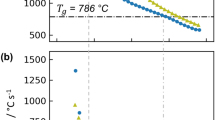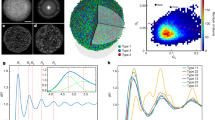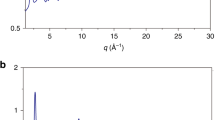Abstract
Full understanding of atomic arrangement in amorphous oxides both at ambient and high pressure is an ongoing fundamental puzzle. Whereas the structures of archetypal oxide glasses such as v-B2O3 at high pressure are essential to elucidate origins of anomalous macroscopic properties of more complex melts, knowledge of the high-pressure structure and pressure-induced coordination changes of these glasses has remained elusive due to lack of suitable in situ experimental probes. Here, we report synchrotron inelastic X-ray scattering results for v-B2O3 at pressures up to 22.5 GPa, revealing the nature of pressure-induced bonding changes and the structure. Direct in situ measurements show a continuous transformation from tri-coordinated to tetra-coordinated boron beginning at 4–7 GPa with most of the boron tetra-coordinated above 20 GPa, forming dense tetrahedral v-B2O3. After decompression from high pressure the bonding reverts back to tri-coordinated boron but with the data suggesting a permanent densification.
This is a preview of subscription content, access via your institution
Access options
Subscribe to this journal
Receive 12 print issues and online access
$259.00 per year
only $21.58 per issue
Buy this article
- Purchase on Springer Link
- Instant access to full article PDF
Prices may be subject to local taxes which are calculated during checkout





Similar content being viewed by others
References
Wolf, G. H. & McMillan, P. F. in Structure, Dynamics, and Properties of Silicate Melts (eds Stebbins, J. F., McMillan, P. F. & Dingwell, D. B.) 505–562 (Mineralogical Society of America, Washington DC, 1995).
Elliot, S. R. Physics of Amorphous Materials (Wiley, New York, 1988).
Hemley, R. J., Mao, H. K., Bell, P. M. & Mysen, B. O. Raman spectroscopy of SiO2 glass at high pressure. Phys. Rev. Lett. 57, 747–750 (1986).
Yarger, J. L. et al. Al coordination changes in high-pressure aluminosilicate liquids. Science 270, 1964–1967 (1995).
Dingwell, D. B., Pichavant, M. & Holtz, F. in Boron, Mineralogy, Petrology and Geochemistry (eds Grew, E. S. & Anovitz, L. M.) 331–385 (Mineralogical Society of America, Washington DC, 1996).
Lee, S. K., Cody, G. D., Fei, Y. & Mysen, B. O. The nature of polymerization and properties of silicate glasses and melts at high pressure. Geochim. Cosmochim. Acta 68, 4189–4200 (2004).
Angell, C. A., Cheeseman, P. A. & Tamaddon, S. Pressure enhancement of ion mobilities in liquid silicates from computer simulations studies to 800 kbar. Science 218, 885–887 (1982).
Guthrie, M. et al. The formation and structure of a dense octahedral glass. Phys. Rev. Lett. 93, 115502 (2004).
Bray, P. J. Nuclear magnetic resonance studies of glass structure. J. Non-Cryst. Solids 73, 19–45 (1985).
Lee, S. K., Musgrave, C. B., Zhao, P. & Stebbins, J. F. Topological disorder and reactivity of borosilicate glasses: Ab initio molecular orbital calculations and 17O and 11B NMR. J. Phys. Chem. B 105, 12583–12595 (2001).
Youngman, R. E., Haubrich, S. T., Zwanziger, J. W., Janicke, M. T. & Chmelka, B. F. Short- and intermediate-range structural ordering in glassy boron oxide. Science 269, 1416–1420 (1995).
Swenson, J. & Borjesson, L. Fraction of boroxol rings in vitreous boron trioxide. Phys. Rev. B 55, 11138–11143 (1997).
Lee, S. K., Fei, Y., Cody, G. D. & Mysen, B. O. Order and disorder of sodium silicate glasses and melts at 10 GPa. Geophys. Res. Lett. 30, 1845 (2003).
Du, L. S., Allwardt, J. R., Schmidt, B. C. & Stebbins, J. F. Pressure-induced structural changes in a borosilicate glass-forming liquid: boron coordination, non-bridging oxygens, and network ordering. J. Non-Cryst. Solids 337, 196–200 (2004).
Lee, S. K., Mibe, K., Fei, Y., Cody, G. D. & Mysen, B. O. Structure of B2O3 glass at high pressure: B-11 solid-state NMR study. Phys. Rev. Lett. 94, 165507 (2005).
Meng, Y. et al. The formation of sp(3) bonding in compressed BN. Nature Mater. 3, 111–114 (2004).
Mao, W. L. et al. Bonding changes in compressed superhard graphite. Science 302, 425–427 (2003).
Wernet, P. et al. The structure of the first coordination shell in liquid water. Science 304, 995–999 (2004).
Bowron, D. T. et al. X-ray-Raman scattering from the oxygen K edge in liquid and solid H2O . Phys. Rev. B. 62, R9223–R9227 (2000).
Cai, Y. Q. et al. Ordering of hydrogen bonds in high-pressure low-temperature H2O . Phys. Rev. Lett. 94, 025502 (2005).
Schwarz, W. H. E., Mensching, L., Hallmeier, K. H. & Szargan, R. K-shell excitation of BF3, CF4 and MBF4 compouds. Chem. Phys. 82, 57–65 (1983).
Fleet, M. E. & Muthupari, S. Boron K-edge XANES of borate and borosilicate minerals. Am. Mineral. 85, 1009–1021 (2000).
Muramatsu, Y., Oshima, M. & Kato, H. Resonant x-ray Raman scattering in B Ka emission spectra of boron oxide (B2O3) excited by undulator radiation. Phys. Rev. Lett. 71, 448–451 (1993).
Yun, Y. H. & Bray, P. J. Nuclear magnetic resonance studies of the glasses in the system Na2O–B2O3–SiO2 . J. Non-Cryst. Solids 27, 363–380 (1978).
Fleet, M. E. & Muthupari, S. Cordination of boron in alkali borosilicate glasses using XANES. J. Non-Cryst. Solids 255, 233–241 (1999).
Grimsditch, M., Polian, A. & Wright, A. C. Irreversible structural changes in vitreous B2O3 under pressure. Phys. Rev. B 54, 152–155 (1996).
Nicholas, J., Sinogeikin, S., Kieffer, J. & Bass, J. Spectroscopic evidence of polymorphism in vitreous B2O3 . Phys. Rev. Lett. 92, 215701 (2004).
Garvie, I. A. J., Craven, A. J. & Brydson, R. Parallel electron energy-loss spectroscopy (PEELS) study of B in minerals: The electron energy-loss near edge structure (ELNES) of the B K-edge. Am. Mineral. 80, 1132–1144 (1995).
Sauer, H., Brydson, R., Rowley, P. N., Engel, W. & Thomas, J. M. Determination of coordination and coordination specific site occupancy by electron-energy loss spectroscopy: An investigation of boron-oxygen compounds. Ultramicroscopy 49, 198–209 (1993).
Muramatsu, Y. et al. Valence band structure and decay process in the inner shell excitation of boron oxide. X-ray Spectrom. 28, 503–508 (1999).
Wright, A. C. et al. Structure of pressure compacted vitreous boron oxide. Phys. Chem. Glasses 41, 296–299 (2000).
Takada, A. Molecular dynamics study of pressure induced structural changes in B2O3 . Phys. Chem. Glasses 45, 156–159 (2004).
Lacy, E. D. Aluminum in glasses and melts. Phys. Chem. Glasses 4, 234–238 (1963).
Stebbins, J. F. & Xu, Z. NMR evidence for excess non-bridging oxygen in aluminosilicate glass. Nature 390, 60–62 (1997).
Toplis, M. J., Dingwell, D. B. & Lenci, T. Peraluminous viscosity maxima in Na2O-Al2O3-SiO2 liquids: the role of triclusters in tectosilicate melts. Geochim. Cosmochim. Acta 61, 2605–2612 (1997).
Lee, S. K. The structure of silicate melts at high pressure: Quantum chemical calculations and solid state NMR. J. Phys. Chem. B. 108, 5889–5900 (2004).
Acknowledgements
We thank W. Mao, R. Hemley, T. Trainor, G. Shen, J. -F. Lin, C. -C. Kao, G. Cody, W.Sturhahn and B. Mysen for their helpful discussion, and J. Ciston and S. Ghose for help during the measurements. Use of the Advanced Photon Source was supported by DOE Basic Energy Sciences (BES). GSECARS was supported by DOE-BES-Geosciences, NSF—Earth Sciences and the State of Illinois. HPCAT was supported by DOE-BES-Materials Science, DOE-NNSA, CDAC, NSF, DOD–TACOM, and the W. M. Keck Foundation. S.K.L. was supported by funds from BK21 in Korea and a Young Scientist award from Korea Research Foundation.
Author information
Authors and Affiliations
Corresponding author
Ethics declarations
Competing interests
The authors declare no competing financial interests.
Rights and permissions
About this article
Cite this article
Lee, S., Eng, P., Mao, Hk. et al. Probing of bonding changes in B2O3 glasses at high pressure with inelastic X-ray scattering. Nature Mater 4, 851–854 (2005). https://doi.org/10.1038/nmat1511
Received:
Accepted:
Published:
Issue Date:
DOI: https://doi.org/10.1038/nmat1511
This article is cited by
-
Selection of optimum composition of aluminoborosilicate glasses with excellent dielectric properties according to orthogonal experiment design
Journal of Materials Science: Materials in Electronics (2018)
-
Irreversibility of Pressure Induced Boron Speciation Change in Glass
Scientific Reports (2014)
-
Iron speciation in minerals and glasses probed by \(\hbox{M}_{2/3}\) M 2 / 3 -edge X-ray Raman scattering spectroscopy
Contributions to Mineralogy and Petrology (2014)
-
Hidden polymorphs drive vitrification in B2O3
Nature Materials (2012)
-
Direct tomography with chemical-bond contrast
Nature Materials (2011)



